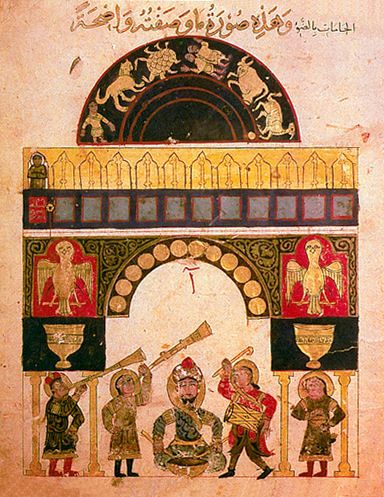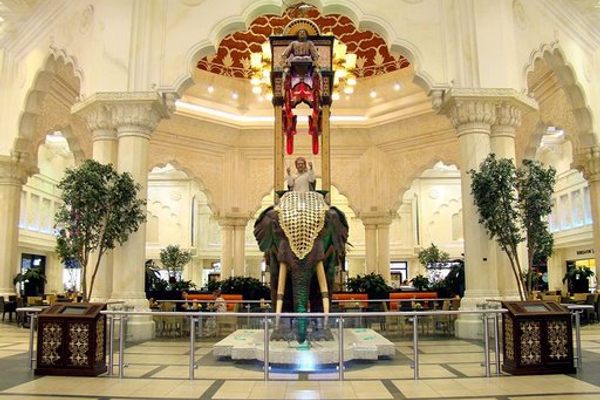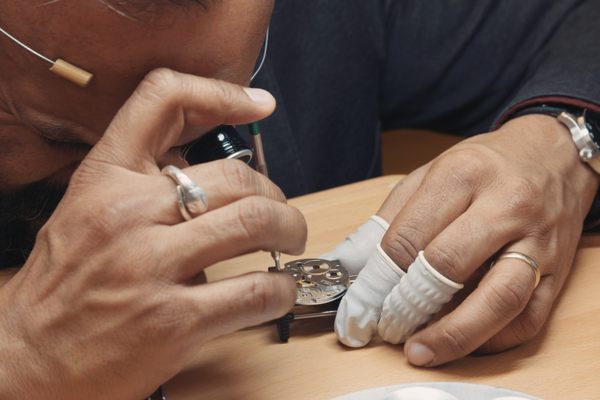The Robot Clocks of 12th-Century Turkey
Al Jazari was not only an exceptional engineer and inventor, but also an incredibly talented illustrator. The elephant clock is perhaps his most famous invention. (Photo: Public Domain/Wikipedia Commons)
During his 70 years on Earth, Turkish scholar and inventor Al-Jazari built an impressive range of robots, clocks, and robot clocks. What’s even more impressive is that he created the bulk of them during the 12th century.
Al-Jazari (1136-1206), whose full name was Al-Shaykh Ra’is al-A`mal Badi`al-Zaman Abu al-‘Izz ibn Isma`il ibn al-Razzaz al-Jazari, worked as the chief engineer at Artuklu Palace, headquarters of the Artuqid dynasty that ruled over parts of Turkey, Syria and Iraq in the 11th and 12th centuries. During his time there, he invented a large number of devices that revolutionized mechanical engineering: everything from a mechanical waitress who served drinks to a group of robot musicians who played their instruments on a lake in the palace to entertain guests.

While these inventions may seem trivial today, their contribution to engineering is indubitable due to their complex mechanisms and design concepts. Al-Jazari was the first to use crank shafts, cog wheels, delivery pipes, and one-way valves in pumps, among other innovations. Donald R. Hill, an English historian who specializes in Islamic mechanics, wrote in Studies in Medieval Islamic Technology that “the impact of al-Jazari’s inventions is still felt in modern contemporary mechanical engineering.”
Perhaps Al-Jazari’s most wondrous inventions were his clocks, because they were about so much more than just telling the time. In addition to designing several water clocks, he invented the Elephant Clock, the Castle Clock, and the most complex candle clock known to date. Here they are below, in miniature drawings illustrated by Al-Jazari himself, who was also an accomplished artist—as if being a mechanical genius wasn’t enough.
 A fully functional reproduction of the Elephant Clock at a shopping mall in Dubai. (Photo: Jonathan Bowen/Wikipedia Commons CC BY-SA 3.0)
A fully functional reproduction of the Elephant Clock at a shopping mall in Dubai. (Photo: Jonathan Bowen/Wikipedia Commons CC BY-SA 3.0)
Elephant Clock
Al-Jazari’s Elephant Clock may be his most famous invention, with many modern reproductions scattered around the globe. Here’s how it works. According to the writings of Islamic explorer Ibn Batuta, the mechanism is housed in a tank of water within the body of the elephant. In the water sits a container with a hole in the bottom that regulates the speed at which it sinks. The perforated bowl is attached to a rope and a system of pulleys, which moves the scribe that sits atop the elephant as it sinks over the course of 30 minutes.
When the bowl is full, it sinks to the bottom, and triggers a single ball at the top of the clock. The ball falls down the mechanism, triggering the phoenix that crowns the clock, and drops out of one of the falcon’s beaks and into one of the snake’s mouths. The serpent rotates around its pivot with the weight of the ball. This action serves two purposes. First, a rope is pulled that resets the bowl in the tank at the surface of the water. And secondly, the ball is dropped from the snake’s mouth into a vessel behind the mahout, triggering him to hit a cymbal to sound the half hour.

Al Jazari’s illustration of his Castle Clock. The hours since sunrise were shown on the open doors along the top of the clock. (Photo: Public Domain/Wikipedia Commons)
Castle Clock
The Castle Clock was Al-Jazari’s largest astronomical clock. It stood at 11 feet high, and told not just the time, but the zodiac and the lunar and solar orbits via a large rotating dial at its crown. It was so complex that it has been referred to as the first analog computer.
The clock had a gold zodiac dial, bronze birds on its battlements, and a group of five mechanical musicians at its gate. The hours since sunrise were shown by the open doors along the top of the clock, as well as by round windows that lit up along with the passage of the sun.
That’s not all, however. According to professor of mechanical engineering Salim Al Hassani, the minutes were reflected by a crescent moon that served as a pointer and traveled across the frieze through the day. Each movement was regulated by a series of reservoirs, troughs and pulleys. Every hour, as the doors at the top opened, two balls would be released through the mouths of the gold falcons on either side into two copper vases.
Three times a day, a pulley unplugged a trough, and water flowed into a scoop wheel, triggering the five musicians to begin playing. With a clock like that, who would ever want to hit the snooze button?

This is not your average candle clock: it contains automata—the first mechanical robots. (Photo: Public Domain/Wikipedia Commons)
Candle Clock
Hill describes Al-Jazari’s Candle Clock as the most sophisticated candle clock known to date. A traditional candle clock is a fairly simple device: a candle is marked with time denominations, and as the wax melts down to each marking the number of hours can be measured.
Al-Jazari’s candle clock functions on this base principle, but since it is an Al-Jazari Clock™ it is also far more complicated than that.
According to Hill, “the bottom of the candle rested in a shallow dish that had a ring on its side connected through pulleys to a counterweight.” When the candle melted away, the weight pushed the candle upwards at a constant speed. This “shallow dish” the candle sat in was a bayonet mount, and the clock was the first device to ever use it. Bayonet mounts are now a standard fitting for light bulbs around the world.

This story appeared as part of Atlas Obscura’s Time Week, a week devoted to the perplexing particulars of keeping time throughout history. See more Time Week stories here.










Follow us on Twitter to get the latest on the world's hidden wonders.
Like us on Facebook to get the latest on the world's hidden wonders.
Follow us on Twitter Like us on Facebook